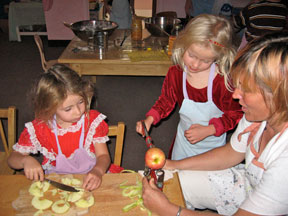Second Grade
 Developmental Profile of a Second Grade Child*
Developmental Profile of a Second Grade Child*
The eight year old child continues to reside in a largely self-created psychological landscape. The events and experiences of the outside world are filtered through the child’s imagination and rearranged to accord with the child’s homogenous world-picture.
Cognitively, the child continues to be at home in an environment where content is presented in a richly pictorial way. Concepts are best understood when they are mobile and organic in quality.
Educational Experience
This year, children continue to familiarize themselves with the fundamentals of arithmetic and literacy, further developing a repertoire of skills that were initially introduced in grade 1. The curriculum content for this age serves to cultivate a sense of breadth and richness of the language of the feelings and emotions. Teachers continue to use movement, rhythm and rhyme as a key instructional tool.
|
History/Social Studies
|
Native American legends as part of American History. |
|
Literature
|
Legends and animal fables and Native American legends. |
|
English and Grammar
|
Small letters, reading, plays, speech work, spelling, punctuation, grammar. |
|
Foreign Language
|
Counting, names of animals, family members, parts of the body, foods, etc. |
|
Geography
|
The environment through observation. |
|
Sciences
|
Nature studies from stories in an imaginative manner. |
|
Mathematics
|
Times tables, time, money, situation problems, geometric shapes, number sequences. |
|
Music
|
Pentatonic flute, folk songs. |
|
Drawing
|
Symmetry, mirror drawing, form drawing. |
|
Painting
|
Introduction of secondary colors; animal forms. |
|
Handwork
|
Knitting and purling; knitted animals. |
|
Modeling
|
Beeswax: scenes from legends, fables, etc. |
|
Eurythmy
|
Pentatonic pitch, rhythm & tones; geometric forms. |
|
Physical Education
|
Jump rope, hop scotch, rhythmic games. |
* The Educational Tasks and Content of the Steiner Waldorf Curriculum, Edited by Martyn Rawson and Tobias Ritcher


